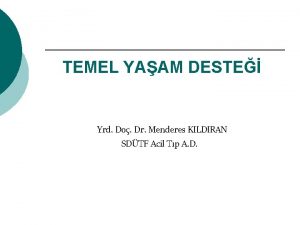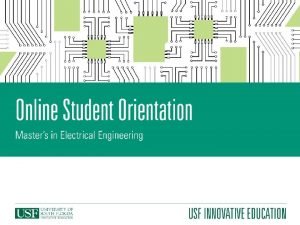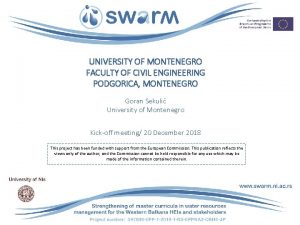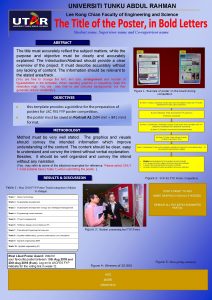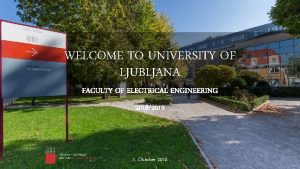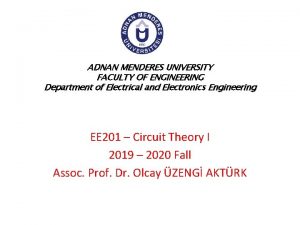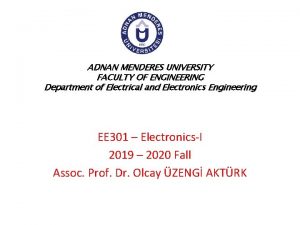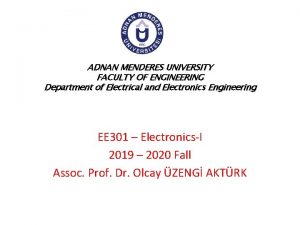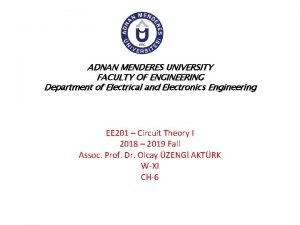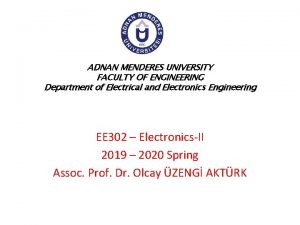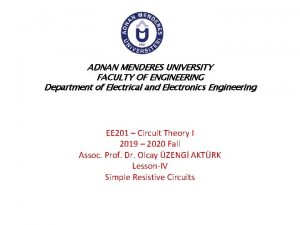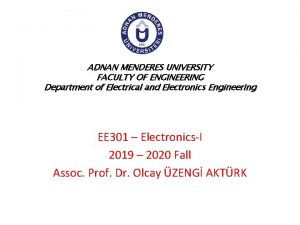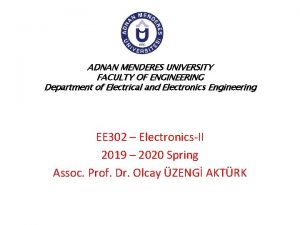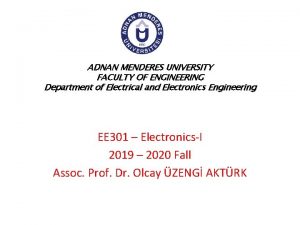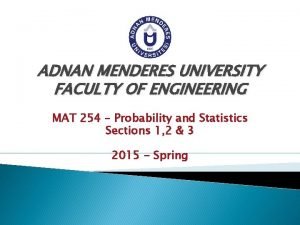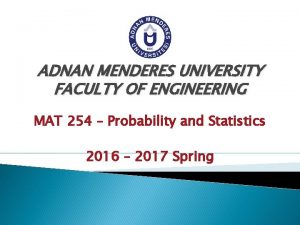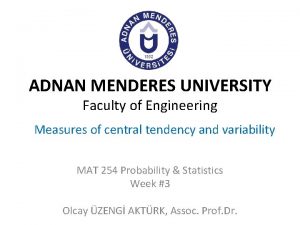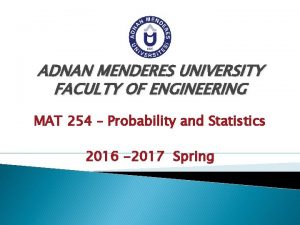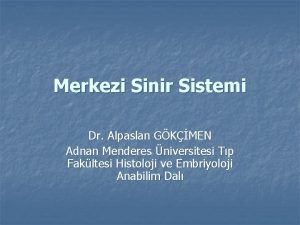ADNAN MENDERES UNIVERSITY FACULTY OF ENGINEERING Department of



































- Slides: 35

ADNAN MENDERES UNIVERSITY FACULTY OF ENGINEERING Department of Electrical and Electronics Engineering EE 201 – Circuit Theory I 2019 – 2020 Fall Assoc. Prof. Dr. Olcay ÜZENGİ AKTÜRK Lesson-VII CH-4

Ch 4: Source Transformations Ø Turned off the sources. Ø Voltage source is short circuited. (V=0) Ø Current source is open circuited. (i=0) Ø Short circuited terminals a-b. Ø In order for the two circuit s to be equivalent Hence, source transformation requires that: EE 201 -Circuit Theory I, Assoc. Prof. Dr. Olcay ÜZENGİ AKTÜRK, 2018 -2019 Fall

Ch 4: Thevenin’s &Norton’s Theorems Linearity is the property of an element describing a linear relationship between cause and effect. The property is a combination of both the homogeneity (scaling) property and the additivity property. ad ho m og ity en tiv ei di ty Ø In general, a linear system must hold ² A linear circuit is one whose output is linearly related (or directly proportional) to its input. EE 201 -Circuit Theory I, Assoc. Prof. Dr. Olcay ÜZENGİ AKTÜRK, 2018 -2019 Fall

Ch 4: Thevenin’s &Norton’s Theorems Ø As a typical example, a household outlet terminal may be connected to different appliances constituting a variable load. Ø Each time the variable element is changed, the entire circuit has to be analyzed all over again. Ø To avoid this problem, Thevenin’s and Norton’s theorems provide a technique by which the fixed part of the circuit is replaced by an equivalent circuit. Thevenin equivalent EE 201 -Circuit Theory I, Assoc. Prof. Dr. Olcay ÜZENGİ AKTÜRK, 2018 -2019 Fall Norton equivalent

Ch 4: Thevenin’s &Norton’s Theorems Ø To find the Thevenin equivalent voltage 1. 2. Make open-circuit to terminals a-b (by removing the load) Find the voltage across the open-circuited terminals a-b EE 201 -Circuit Theory I, Assoc. Prof. Dr. Olcay ÜZENGİ AKTÜRK, 2018 -2019 Fall

Ch 4: Thevenin’s Theorem(Thevenin equivalent Circuit) Ø To find the Thevenin equivalent resistance If circuit does not include dependent sources (we have 2 methods) 1. i. Make open-circuit to terminals a-b 1. ii. Kill (turn off) all independent sources (v=0, i=0) 1. iii. Then, 2. i. Make short-circuit to terminals a-b 2. ii. Find the short-circuit current 2. iii. Then, EE 201 -Circuit Theory I, Assoc. Prof. Dr. Olcay ÜZENGİ AKTÜRK, 2018 -2019 Fall

Ch 4: Thevenin’s Theorem(Thevenin equivalent Circuit) Ø To find the Thevenin equivalent resistance If circuit 1. 2. 3. 4. 5. include dependent sources Make open-circuit to terminals a-b Kill (turn off) all independent sources (v=0, i=0) Apply a test voltage source v 0 (or current source i 0 ) between the terminals a-b Find the unknown test current i 0 (or test voltage v 0 ) Then, EE 201 -Circuit Theory I, Assoc. Prof. Dr. Olcay ÜZENGİ AKTÜRK, 2018 -2019 Fall

Ch 4: Norton’s theorem(Norton equivalant circuit) Ø Finding the Norton equivalent circuit is simple (As you learned to obtain Thevenin equivalent circuit) *As we found in Thevenin method to calculate RTh Ø One can use source transformation to obtain Norton equivalent circuit from Thevenin equivalent one. EE 201 -Circuit Theory I, Assoc. Prof. Dr. Olcay ÜZENGİ AKTÜRK, 2018 -2019 Fall

Ch 4: • Practice Problem: Find the Norton equivalent circuit of the circuit shown? EE 201 -Circuit Theory I, Assoc. Prof. Dr. Olcay ÜZENGİ AKTÜRK, 2018 -2019 Fall

Ch 4: Norton’s Theorem (Norton equivalent Circuit) • Practice Problem: Find the Norton equivalent circuit of the circuit shown? EE 201 -Circuit Theory I, Assoc. Prof. Dr. Olcay ÜZENGİ AKTÜRK, 2018 -2019 Fall

Ch 4: Maximum Power Transfer Ø In many practical situations, a circuit is designed to provide power to a load. Ø While for electric utilities, minimizing power losses in the process of transmission and distribution is critical for efficiency and economic reasons, there are other applications in areas such as communications where it is desirable to maximize the power delivered to a load. Ø Thevenin equivalent is useful in finding the maximum power a linear circuit can deliver to a load. Ø We assume that we can adjust the load resistance EE 201 -Circuit Theory I, Assoc. Prof. Dr. Olcay ÜZENGİ AKTÜRK, 2018 -2019 Fall

Ch 4: Ø Maximum Power Transfer Ø If the entire circuit is replaced by its Thevenin equivalent except for the load, the power delivered to the load is: Ø To find the value of load resistor when the power transferred to the resistor is maximum, we must differentiate the equation above RL. Then, resistance value can be found by equalizing these equations to zero. EE 201 -Circuit Theory I, Assoc. Prof. Dr. Olcay ÜZENGİ AKTÜRK, 2018 -2019 Fall

Ch 4: Ø Maximum Power Transfer showing that the maximum power transfer takes place when the load resistance equals the Thevenin resistance. In this case, the source and load are said to be matched. EE 201 -Circuit Theory I, Assoc. Prof. Dr. Olcay ÜZENGİ AKTÜRK, 2018 -2019 Fall

Ch 4: Maximum Power Transfer • Example: Find the value of RL for maximum power transfer in the circuit below. Find the maximum power? EE 201 -Circuit Theory I, Assoc. Prof. Dr. Olcay ÜZENGİ AKTÜRK, 2018 -2019 Fall

Ch 4: Maximum Power Transfer • Practice Problem: Find the value of RL below. Find the maximum power? for maximum power transfer in the circuit EE 201 -Circuit Theory I, Assoc. Prof. Dr. Olcay ÜZENGİ AKTÜRK, 2018 -2019 Fall

Ch 4: Superposition Principle Ø The idea of superposition rests on the linearity property. Ø The superposition principle states that the voltage across (or current through) an element in a linear circuit is the algebraic sum of the voltages across (or currents through) that element due to each independent source acting alone. Ø The principle of superposition helps us to analyze a linear circuit with more than one independent source by calculating the contribution of each independent source separately. EE 201 -Circuit Theory I, Assoc. Prof. Dr. Olcay ÜZENGİ AKTÜRK, 2018 -2019 Fall

Ch 4: Superposition Principle Ø To apply the superposition principle, we must keep two things in mind: 1. We consider one independent source at a time while all other independent sources are turned off. • Voltage sources are short-circuited (V=0) • Current sources are open-circuited (i=0) 2. Dependent sources are left intact because they are controlled by circuit variables. Ø § § § Steps to apply the superposition principle: Turn off all independent sources except one source. Find the output (voltage or current) due to that active source using nodal or mesh analysis. Repeat step 1 for each of the other independent sources. Find the total contribution by adding algebraically all the contributions due to the independent sources. EE 201 -Circuit Theory I, Assoc. Prof. Dr. Olcay ÜZENGİ AKTÜRK, 2018 -2019 Fall

Ch 4: Superposition Principle • Example: Use the superposition theorem to find EE 201 -Circuit Theory I, Assoc. Prof. Dr. Olcay ÜZENGİ AKTÜRK, 2018 -2019 Fall in the circuit below.

Ch 4: Superposition Principle • Example: Use the superposition theorem to find i 0 in the circuit below. EE 201 -Circuit Theory I, Assoc. Prof. Dr. Olcay ÜZENGİ AKTÜRK, 2018 -2019 Fall

Ch 4: Superposition Principle • Practice Problem: Use the superposition theorem to find EE 201 -Circuit Theory I, Assoc. Prof. Dr. Olcay ÜZENGİ AKTÜRK, 2018 -2019 Fall in the circuit below.

Ch 4: Superposition Principle • Practice Problem: Use the superposition theorem to find EE 201 -Circuit Theory I, Assoc. Prof. Dr. Olcay ÜZENGİ AKTÜRK, 2018 -2019 Fall in the circuit below.

Ch 5: Operational Amplifiers(Op-Amp’s) Ø Having learned the basic laws and theorems for circuit analysis, we are now ready to study an active circuit element of paramount importance: the operational amplifier, or op-amp for short. Ø The op-amp is a versatile circuit building block. Ø The op-amp is an electronic unit that behaves like a voltage-controlled voltage source. Ø It can also be used in making a voltage- or current-controlled current source. An op amp can sum signals, amplify a signal, integrate it, or differentiate it. The ability of the op amp to perform these mathematical operations is the reason it is called an operational amplifier. It is also the reason for the widespread use of op amps in analog design. Ø Op-amps are popular in practical circuit designs because they are versatile, inexpensive, easy to use, and fun to work with. EE 201 -Circuit Theory I, Assoc. Prof. Dr. Olcay ÜZENGİ AKTÜRK, 2018 -2019 Fall

Ch 5: Operational Amplifiers(Op-Amp’s) Ø An operational amplifier is designed so that it performs some mathematical operations when external components, such as resistors and capacitors, are connected to its terminals. Ø An op-amp is an active circuit element designed to perform mathematical operations of addition, subtraction, multiplication, division, differentiation, and integration. Ø The op-amp is an electronic device consisting of a complex arrangement of resistors, transistors, capacitors, and diodes. Ø A full discussion of what is inside the op amp is beyond the scope of this chapter. It will suffice to treat the op amp as a circuit building block and simply study what takes place at its terminals. Ø EE 201 -Circuit Theory I, Assoc. Prof. Dr. Olcay ÜZENGİ AKTÜRK, 2018 -2019 Fall

Ch 5: Operational Amplifiers(Op-Amp’s) ² Op amps are commercially available in integrated circuit packages in several forms. EE 201 -Circuit Theory I, Assoc. Prof. Dr. Olcay ÜZENGİ AKTÜRK, 2018 -2019 Fall

Ch 5: Operational Amplifiers(Op-Amp’s) Ø A typical one is the eight-pin dual in-line package (or DIP). Pin or terminal 8 is unused, and terminals 1 and 5 are of little concern to us. The five important terminals are: 1. The inverting input, pin 2. 2. The non-inverting input, pin 3. 3. The output, pin 6. 4. The positive power supply V+, pin 7. 5. The negative power supply V−, pin 4. EE 201 -Circuit Theory I, Assoc. Prof. Dr. Olcay ÜZENGİ AKTÜRK, 2018 -2019 Fall

Ch 5: Operational Amplifiers(Op-Amp’s) • As an active element, the op amp must be powered by a voltage supply as typically shown below Although the power supplies are often ignored in op amp circuit diagrams for the sake of simplicity, the power supply currents must not be overlooked. By KCL, EE 201 -Circuit Theory I, Assoc. Prof. Dr. Olcay ÜZENGİ AKTÜRK, 2018 -2019 Fall

Ch 5: Operational Amplifiers(Op-Amp’s) • • • The equivalent circuit model of an op amp is shown in Figure below. The output section consists of a voltage-controlled source in series with the output resistance Ro. The input resistance Ri is the Thevenin equivalent resistance seen at the input terminals, while the output resistance R 0 is the Thevenin equivalent resistance seen at the output. Ø EE 201 -Circuit Theory I, Assoc. Prof. Dr. Olcay ÜZENGİ AKTÜRK, 2018 -2019 Fall The differential input voltage is given by;

Ch 5: Operational Amplifiers(Op-Amp’s) Ø A is called the open-loop voltage gain because it is the gain of the op-amp without any external feedback from output to input. EE 201 -Circuit Theory I, Assoc. Prof. Dr. Olcay ÜZENGİ AKTÜRK, 2018 -2019 Fall

Ch 5: Operational Amplifiers(Op-Amp’s) EE 201 -Circuit Theory I, Assoc. Prof. Dr. Olcay ÜZENGİ AKTÜRK, 2018 -2019 Fall

Ch 5: Operational Amplifiers(Op-Amp’s) Actually NO !!!! Ø A practical limitation of the op-amp is that the magnitude of its output voltage cannot exceed |Vcc|. In other words, the output voltage is dependent on and is limited by the power supply voltage. EE 201 -Circuit Theory I, Assoc. Prof. Dr. Olcay ÜZENGİ AKTÜRK, 2018 -2019 Fall

Ch 5: Operational Amplifiers(Op-Amp’s) Ø The concept of feedback is crucial to our understanding of op-amp circuits. Ø When there is a feedback path from output to input, input the ratio of the output voltage to the input voltage is called the closed-loop gain Ø A negative feedback is achieved when the output is fed back to the inverting terminal of the op amp. Ø As a result of the negative feedback, it can be shown that the closed-loop gain is almost insensitive to the open-loop gain A of the op-amp. Ø For this reason, op-amps are used in circuits with feedback paths EE 201 -Circuit Theory I, Assoc. Prof. Dr. Olcay ÜZENGİ AKTÜRK, 2018 -2019 Fall

Ch 5: Operational Amplifiers(Op-Amp’s) • Voltage transfer characteristic of an op-amp Ø If we attempt to increase vd beyond the linear range, the opamp becomes saturated and yields Vo = Vcc or Vo = −Vcc. EE 201 -Circuit Theory I, Assoc. Prof. Dr. Olcay ÜZENGİ AKTÜRK, 2018 -2019 Fall

Ch 5: Operational Amplifiers(Op-Amp’s) IDEAL OP-AMPS Ø To facilitate the understanding of op amp circuits, we will assume ideal op-amps. An opamp is ideal if it has the following characteristics: 1. Infinite open-loop gain, 2. Infinite input resistance, 3. Zero output resistance, Ø An ideal op amp is an amplifier with infinite open-loop gain, infinite input resistance, and zero output resistance. Ø Two important characteristics of the ideal op amp are: (Output current still exist!) (Virtual short condition. ) EE 201 -Circuit Theory I, Assoc. Prof. Dr. Olcay ÜZENGİ AKTÜRK, 2018 -2019 Fall

Ch 5: Operational Amplifiers(Op-Amp’s) IDEAL OP-AMPS (Output current still exist!) (Virtual short condition. ) Ø These are only valid for LINEAR REGION !!!! Ø Unless otherwise is stated, OP-AMP’s are IDEAL in this course. EE 201 -Circuit Theory I, Assoc. Prof. Dr. Olcay ÜZENGİ AKTÜRK, 2018 -2019 Fall

Ch 5: Operational Amplifiers(Op-Amp’s) Analyzing the OP-AMP Circuits Example : Find i 0 and v 0 ? (Op-amp is ideal) EE 201 -Circuit Theory I, Assoc. Prof. Dr. Olcay ÜZENGİ AKTÜRK, 2018 -2019 Fall
 Yoq amına
Yoq amına Karotis manevrası yapmak
Karotis manevrası yapmak Menderes sargın
Menderes sargın Faculty of engineering university of porto
Faculty of engineering university of porto Lebanese university faculty of engineering
Lebanese university faculty of engineering Clemson university electrical engineering faculty
Clemson university electrical engineering faculty Faculty of mechanical engineering thammasat university
Faculty of mechanical engineering thammasat university Department of information engineering university of padova
Department of information engineering university of padova Department of information engineering university of padova
Department of information engineering university of padova University of sargodha engineering department
University of sargodha engineering department Nit calicut chemistry
Nit calicut chemistry Lee kong chian faculty of engineering and science
Lee kong chian faculty of engineering and science Czech technical university in prague civil engineering
Czech technical university in prague civil engineering Benha faculty of engineering
Benha faculty of engineering Usf canvas
Usf canvas Civil engineering faculty
Civil engineering faculty St anns college chirala
St anns college chirala Etfbl
Etfbl Hijjawi faculty for engineering technology
Hijjawi faculty for engineering technology Lee kong chian faculty of engineering and science
Lee kong chian faculty of engineering and science Andy fisher mun
Andy fisher mun Fe spletna učilnica
Fe spletna učilnica University of split faculty of maritime studies
University of split faculty of maritime studies Bridgeport engineering department
Bridgeport engineering department Computer science tutor bridgeport
Computer science tutor bridgeport Hubert kairuki memorial university faculty of medicine
Hubert kairuki memorial university faculty of medicine Semmelweis
Semmelweis King abdulaziz university faculty of medicine
King abdulaziz university faculty of medicine Fsu cs faculty
Fsu cs faculty Faculty of business and economics mendel university in brno
Faculty of business and economics mendel university in brno Singularity university faculty
Singularity university faculty Semmelweis university faculty of medicine
Semmelweis university faculty of medicine Ascaris lumbricoides ova
Ascaris lumbricoides ova Charles university faculty of humanities
Charles university faculty of humanities Faculty of veterinary medicine cairo university logo
Faculty of veterinary medicine cairo university logo Faculty of law of the university of zagreb
Faculty of law of the university of zagreb

